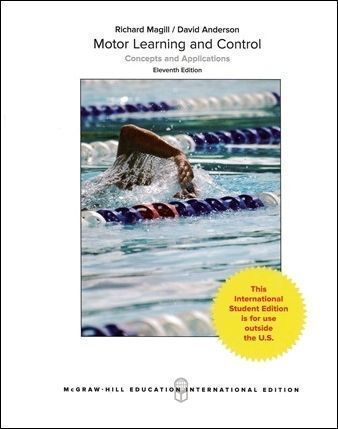Motor Learning and Control: Concepts and Applications 11/e
售價
$
1,500
- 一般書籍
- ISBN:9781260084023
- 作者:Richard Magill, David Anderson
- 版次:11
- 年份:2017
- 出版商:McGraw-Hill
- 頁數/規格:480頁/平裝單色
- 參考網頁:Motor Learning and Control 11/e
書籍介紹
本書特色
目錄
作者介紹
Description
Motor Learning and Control: Concepts and Applications provides an introductory study of motor learning and control for students who aspire to become practitioners in exercise science, physical education, and other movement-oriented professions. The text opens with an introduction to motor skills and control, continues through attention, memory, and learning, and ends with a discussion of instruction, feedback, and practice methods. The text's strong research base, clear presentation and practical applications will help students build a solid foundation in motor skills and prepare them for further exploration on their own.
Instructors and students can now access their course content through the Connect digital learning platform by purchasing either standalone Connect access or a bundle of print and Connect access. McGraw-Hill Connect® is a subscription-based learning service accessible online through your personal computer or tablet. Choose this option if your instructor will require Connect to be used in the course. Your subscription to Connect includes the following:
Motor Learning and Control: Concepts and Applications provides an introductory study of motor learning and control for students who aspire to become practitioners in exercise science, physical education, and other movement-oriented professions. The text opens with an introduction to motor skills and control, continues through attention, memory, and learning, and ends with a discussion of instruction, feedback, and practice methods. The text's strong research base, clear presentation and practical applications will help students build a solid foundation in motor skills and prepare them for further exploration on their own.
Instructors and students can now access their course content through the Connect digital learning platform by purchasing either standalone Connect access or a bundle of print and Connect access. McGraw-Hill Connect® is a subscription-based learning service accessible online through your personal computer or tablet. Choose this option if your instructor will require Connect to be used in the course. Your subscription to Connect includes the following:
- SmartBook® - an adaptive digital version of the course textbook that personalizes your reading experience based on how well you are learning the content.
- Access to your instructor’s homework assignments, quizzes, syllabus, notes, reminders, and other important files for the course.
- Progress dashboards that quickly show how you are performing on your assignments and tips for improvement.
- The option to purchase (for a small fee) a print version of the book. This binder-ready, loose-leaf version includes free shipping.
Features
- Connect: A highly reliable, easy-to-use homework and learning management solution that embeds learning science and award-winning adaptive tools to improve student results.
- This text provides an introductory study of motor learning and control for students who aspire to become practitioners in exercise science, physical education, and other movement-oriented professions.
- With the text's strong research base, clear presentation and practical applications, students will build a solid foundation in motor skills and be prepared for further exploration on their own.
Table of Contents
Unit I: Introduction to Motor Skills and Abilities
1. The Classification of Motor Skills
2. The Measurement of Motor Performance
3. Motor Abilities
Unit II: Introduction to Motor Control
4. Neuromotor Basis for Motor Control
5. Motor Control Theories
6. Sensory Components of Motor Control
7. Performance and Motor Control Characteristics of Functional Skills
8. Action Preparation
Unit III: Attention and Memory
9. Attention as a Limited Capacity Resource
10. Memory Components, Forgetting, and Strategies
Unit IV: Introduction to Motor Skill Learning
11. Defining and Assessing Learning
12. The Stages of Learning
13. Transfer of Learning
Unit V: Instruction and Augmented Feedback
14. Demonstration and Verbal Instructions
15. Augmented Feedback
Unit VI: Practive Conditions
16. Practice Variability and Specificity
17. The Amount and Distribution of Practice
18. Whole and Part Practice
19. Mental Practice
Unit I: Introduction to Motor Skills and Abilities
1. The Classification of Motor Skills
2. The Measurement of Motor Performance
3. Motor Abilities
Unit II: Introduction to Motor Control
4. Neuromotor Basis for Motor Control
5. Motor Control Theories
6. Sensory Components of Motor Control
7. Performance and Motor Control Characteristics of Functional Skills
8. Action Preparation
Unit III: Attention and Memory
9. Attention as a Limited Capacity Resource
10. Memory Components, Forgetting, and Strategies
Unit IV: Introduction to Motor Skill Learning
11. Defining and Assessing Learning
12. The Stages of Learning
13. Transfer of Learning
Unit V: Instruction and Augmented Feedback
14. Demonstration and Verbal Instructions
15. Augmented Feedback
Unit VI: Practive Conditions
16. Practice Variability and Specificity
17. The Amount and Distribution of Practice
18. Whole and Part Practice
19. Mental Practice
Richard Magill, New York University
David Anderson, San Francisco State University
David Anderson, San Francisco State University

